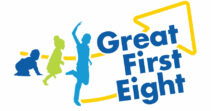Families Q&A
Families have been involved in developing this curriculum from the very beginning. We have held several focus groups with families and community members to hear what they want to see in a curriculum for young children, and we have used families’ input throughout our development process. In addition, many members of our team are parents themselves. Team members who have young children are eager to develop a curriculum in which their children can thrive. Those whose children are older are committed to developing a better curriculum for future generations.
Great First Eight values the expertise of families and includes this expertise in the classroom. To include this expertise, we make sure to actively and consistently communicate with families. Families are invited to share their family experiences as a part of the curriculum. Teachers share with families the content of the curriculum throughout the school year. This sharing of information and active communication and inclusion of families allows families to make connections at home to what their children are learning.
First, Great First Eight is more tightly aligned to research than many other curricula. Every time we had a decision to make in the curriculum—from how much time children should spend on physical activity to what to say when introducing an alphabet letter—we referred to research to inform our decision. Using research in this way makes it more likely that the curriculum will have a positive impact on children.
Second, because young children’s knowledge of the natural and social world will have a large impact on their success in and out of school, Great First Eight incorporates a lot more science, engineering, social studies than other curricula.
Finally, Great First Eight works to ensure that every child feels valued and validated in the classroom. We want to make sure that children feel represented in the books they read and that are read to them. We want to make sure children have an opportunity to learn about people and places in their communities, as well as about people and places less familiar to them. Finally, we want to support teachers in adjusting what and how they teach to meet the strengths and needs of each child.
The bottom line is this: Great First Eight offers a radical improvement in the educational experience of children and families.
No. Critical race theory is an academic theory that is not appropriate for instruction in the birth-through-age-eight years.
We do address race in developmentally appropriate, research-informed ways, as summarized in the one-pager linked above. We also develop children’s ability to be critical. For example, in our first-grade curriculum, one social studies unit focused on economics is called Critical Consumers. One of the products of this unit are Public Service Announcements children develop about the importance of critically analyzing advertisements.
One of our foci when writing the Great First Eight Curriculum was children from historically underrepresented racial and ethnic backgrounds. We are unapologetic about this, as many curricula have been written with little or no attention to children from these backgrounds. We have strived for extensive, positive representation of people from historically underrepresented racial and ethnic backgrounds in every aspect of the curriculum.
Although no set of curriculum materials can, by themselves, guarantee an education that is tailored to each child’s knowledge, cultural background, strengths, and needs, Great First Eight is intentionally designed to better support teachers through both curriculum and professional development materials to provide such an education for each child in their classroom.
Notably, when fewer children from historically underrepresented racial and ethnic backgrounds are in your classrooms, more thought and preparation will be needed to ensure that the curriculum is supportive of, and not harmful to, all children in the classroom. For example, if you are discussing differences among people in physical features, and you have only one child with a particular hair type, you must take care that that child is not singled out in a negative way.
